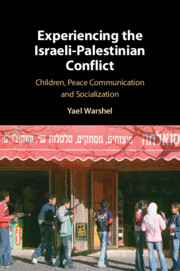Book contents
- Experiencing the Israeli-Palestinian Conflict
- Experiencing the Israeli-Palestinian Conflict
- Copyright page
- Dedication
- Contents
- Figures
- Tables
- Acknowledgments
- Note on the Text
- Abbreviations
- Introduction
- Part I The Encoding and Production of Israeli and Palestinian Sesame Street
- Part II Audience Reception of Israeli and Palestinian Sesame Street
- Part III Situating the Reception of Israeli and Palestinian Sesame Street in Mundane, Intractable Conflict Zone Practices
- Part IV Conclusions and Recommendations to Improve Peace Communication Research, (Evidence-Based) Practice and Conflict Intractability Interpretation
- Introduction to Part IV: The Best Case
- 10 Lessons Learned and Their Application to Peace Communication Research, (Evidence-Based) Practice and Conflict Intractability Interpretation
- 11 How to Improve Potential Media Effects and Impacts
- 12 Follow-Up Study of Tween-Age Former Audience Members
- Book part
- References
- Index
- Plate Section (PDF Only)
11 - How to Improve Potential Media Effects and Impacts
Recommendations for Peace Communication Practitioners
from Part IV - Conclusions and Recommendations to Improve Peace Communication Research, (Evidence-Based) Practice and Conflict Intractability Interpretation
Published online by Cambridge University Press: 08 July 2021
- Experiencing the Israeli-Palestinian Conflict
- Experiencing the Israeli-Palestinian Conflict
- Copyright page
- Dedication
- Contents
- Figures
- Tables
- Acknowledgments
- Note on the Text
- Abbreviations
- Introduction
- Part I The Encoding and Production of Israeli and Palestinian Sesame Street
- Part II Audience Reception of Israeli and Palestinian Sesame Street
- Part III Situating the Reception of Israeli and Palestinian Sesame Street in Mundane, Intractable Conflict Zone Practices
- Part IV Conclusions and Recommendations to Improve Peace Communication Research, (Evidence-Based) Practice and Conflict Intractability Interpretation
- Introduction to Part IV: The Best Case
- 10 Lessons Learned and Their Application to Peace Communication Research, (Evidence-Based) Practice and Conflict Intractability Interpretation
- 11 How to Improve Potential Media Effects and Impacts
- 12 Follow-Up Study of Tween-Age Former Audience Members
- Book part
- References
- Index
- Plate Section (PDF Only)
Summary
This chapter provides seventeen recommendations intended to improve PeaceComm practice worldwide.
The first six recommendations suggest continuing the Sesame Workshop design. The remainder provide a design template for Israeli and Palestinian Sesame Street and other future cross-comparative PeaceComm interventions around the globe. Where relevant, these range from weaving in structural inequality realities and relative narrative approaches to conflict contexts, varying intervention designs by world system categorical target populations, treating children as active human beings when they are the target of interventions and only targeting them if indeed treating them more like adults, developing direct and ongoing relations with communication and peace and conflict scholars, structuring interpersonal communication, treating communication as a process not only product, continuing the use of the embedded factor of production effects model, conceptualizing communication also as a mediating artifact, and cultivating the bicultural “target” of an intervention to be peace-maker mediators-in-the-making. In the case of these conflicts, that means incorporating peacebuilding into child development approaches for Arab/Palestinian Israeli children out of an aim to empower their active future mediation roles
Keywords
- Type
- Chapter
- Information
- Experiencing the Israeli-Palestinian ConflictChildren, Peace Communication and Socialization, pp. 364 - 403Publisher: Cambridge University PressPrint publication year: 2021



